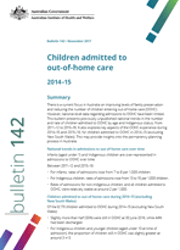Summary
There is a current focus in Australia on improving levels of family preservation and reducing the number of children entering out-of-home care (OOHC). However, national-level data regarding admissions to OOHC have been limited. This bulletin presents previously unpublished national trends in the number and rate of children admitted to OOHC by age and Indigenous status, from 2011–12 to 2015–16. It also explores key aspects of the OOHC experience during 2014–15 and 2015–16, for children admitted to OOHC in 2014–15 (excluding New South Wales). This may provide insights into the permanency planning process in Australia.
National trends in admissions to out-of-home care over time
Infants (aged under 1) and Indigenous children are over-represented in admissions to OOHC over time.
Between 2011–12 and 2015–16:
- For infants, rates of admissions rose from 7 to 8 per 1,000 children.
- For Indigenous children, rates of admissions rose from 13 to 15 per 1,000 children.
- Rates of admissions for non-Indigenous children, and all children admitted to OOHC, were relatively stable at around 2 per 1,000.
Children admitted to out-of-home care during 2014–15 (excluding New South Wales)
Of the 8,170 children admitted to OOHC during 2014–15 (excluding New South Wales):
- Slightly more than half (55%) were still in OOHC at 30 June 2016, while 44% had been discharged.
- For Indigenous children and younger children (aged under 10 at time of admission), the proportion of children still in OOHC was slightly greater at around 3 in 5.
- Nearly half (47%) had only 1 unique care arrangement during their time in OOHC.
- More than 4 in 5 (86%) were in home-based care (family setting with a carer).
For children still in OOHC at 30 June 2016:
- More than a quarter (28%) were on long-term legal orders. This is compared with 6% of these children at the time of their admission, and likely reflects efforts to achieve legal permanency for children requiring long-term alternative care arrangements.
- The percentage in relative/kinship care increased for Indigenous children between admission and 30 June 2016 (from 36% to 50%), while foster care arrangements decreased (from 44% to 32%). This is consistent with the preference for placing Indigenous children within their extended family.
For children who were discharged, most left within less than a year of their admission. Around 3 in 5 (61%) left within less than 6 months of their admission. More than 4 in 5 (82%) left within less than 12 months.



